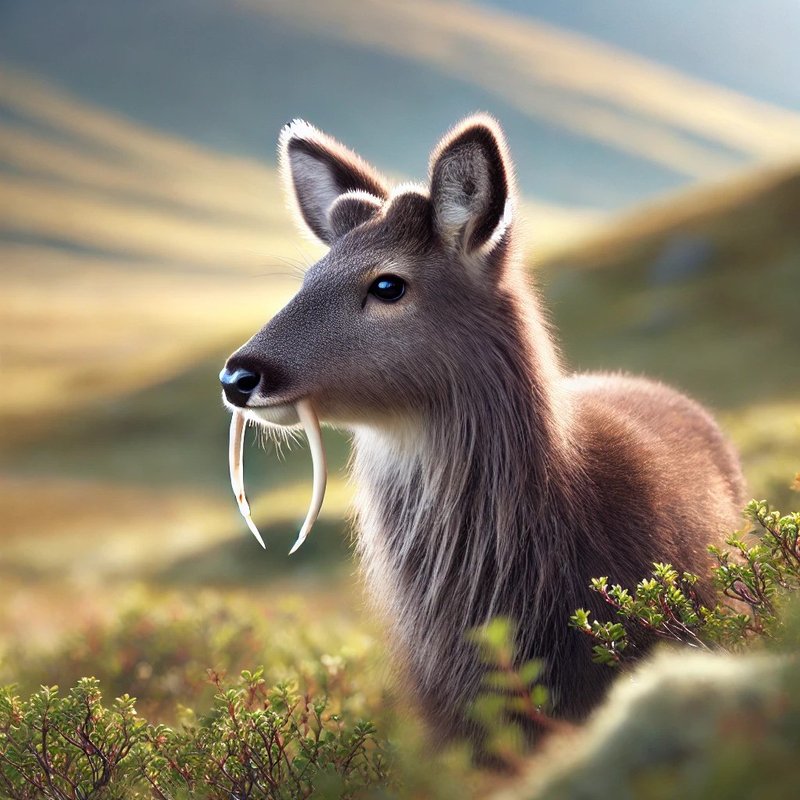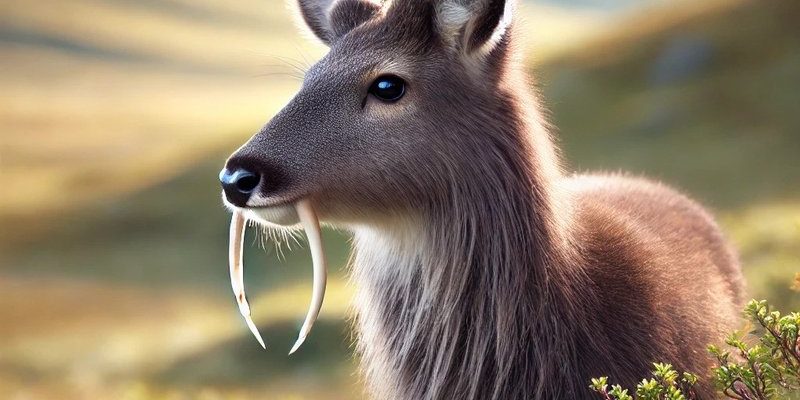
Imagine being at a cozy café, sipping coffee, and discussing the wonders of nature. It’s easy to see how some animals can resemble one another, yet each has its distinct story. Whether it’s the way they adapt to their environments or their unique characteristics, these twelve creatures bring a rich tapestry of life to our world. So, let’s dive in and explore 10 animals that are similar to the musk deer and discover how to tell them apart!
1. Water Deer
First on our list is the water deer. These charming animals are native to China and Korea. What makes them unique? Unlike typical deer, water deer lack antlers; instead, males sport long canine teeth that resemble tusks, giving them a slightly menacing look—a bit like a vampire, don’t you think? They thrive in wetland areas, making them quite adept at swimming and foraging in the water.
In terms of size, water deer are similar to musk deer but tend to be a bit larger. They usually weigh between 50 and 80 pounds. While musk deer have a stockier build, water deer sport longer legs, making them seem a little taller. A quick way to differentiate them is by looking for those distinctive tusks on the males and the absence of antlers.
2. Chinese Serow
Next, let’s talk about the Chinese serow. This animal is a bit of a mix between a goat and a deer, putting it in the same family as the musk deer. Found in the mountainous regions of China, the Chinese serow has a stocky body covered in shaggy fur, which helps it adapt to cold environments.
Unlike the musk deer, serows have short, curved horns that can be a giveaway when identifying them. They also boast a strong, muscular build, which helps them navigate rocky terrains. You’ll likely spot them in pairs or small groups, often foraging for grass and leaves. If you ever find yourself in the hilly areas of China, keep an eye out for these rugged little creatures!
3. Sika Deer
The sika deer is another fascinating relative with a striking appearance. Originating from East Asia, sika deer boast beautiful spotted coats, which give them a similar aesthetic to young musk deer. Adult males have impressive antlers, typically with three tines, making them quite distinct from musk deer.
In terms of habitat, sika deer prefer forests and wetlands, similar to musk deer, helping them camouflage against predators. Size-wise, they’re a bit larger than musk deer, weighing 50 to 110 pounds. If you want to spot one, look for the characteristic white spots on their coat, especially during summer.
4. Reeves’s Muntjac
If you’re looking for a creature that resembles a small deer but has a personality of its own, the Reeves’s muntjac might just fit the bill. These critters are often called barking deer because of their distinct vocalizations. They’re found in East Asia, particularly in forests and grasslands.
Muntjacs are smaller than musk deer, generally weighing between 20 to 40 pounds. One of the key differences is their antlers, which are generally small and often hidden under their fur. They also have a more elongated face. When identifying them, watch for their characteristic barks—a sound you wouldn’t expect from a deer!
5. Chital Deer
Moving on to the chital deer, also known as spotted deer. These animals are a common sight in India and have a striking coat filled with white spots. Chital serve as a reminder that beauty is everywhere in the animal kingdom, even in familiar species.
Chital are significantly larger than musk deer, weighing between 100 to 250 pounds. Their antlers are typically forked and can grow quite large, making them easy to identify. When trying to distinguish them from musk deer, look for the abundant spots and their larger size. If you’re ever on a safari in India, keep your eyes peeled for these eye-catching creatures!
6. Nilgai
Let’s introduce the nilgai, also known as the blue bull. Although they are a type of antelope rather than a deer, their size and shape can be reminiscent of smaller deer. Nilgais are primarily found in the grasslands and forests of India and are known for their bluish-gray coat.
One major way to tell nilgai apart from musk deer is their larger size—adult males can weigh up to 300 pounds! They also have a more elongated body and a distinctly horse-like face. Keep an eye out for their robust build when you’re in the fields of India.
7. Pudu
On the smaller end of the spectrum is the pudu, the smallest deer species in the world. Native to South America, pudus are just about the size of a housecat! These adorable little creatures weigh around 25 to 35 pounds and have a compact body covered in a reddish-brown coat.
Pudus don’t have antlers, which makes them quite similar to musk deer in that regard. However, their diminutive size and the absence of antlers set them apart. If you ever find yourself in the forests of Chile or Argentina, keep your camera ready—you might just catch a glimpse of one of these tiny marvels!
8. Muntjac Deer
Another close relative is the muntjac deer. Extremely adaptable, these deer can be found in various environments, including forests and grasslands. They’re usually small, like musk deer, with males weighing between 30 and 50 pounds.
Muntjacs are easily recognized by their small antlers and elongated faces. Unlike musk deer, they often have a rich brown coat with lighter underbellies. If you’re keen on spotting one, listen for their distinctive barking call, which can often be heard in the early morning hours.
9. European Roe Deer
Next up is the European roe deer. These graceful creatures are found across Europe and are characterized by their reddish-brown fur and small size. They are similar to musk deer in build, though they have longer legs and can weigh between 50 and 120 pounds.
One of the easiest ways to distinguish roe deer is by their forked antlers, which grow in a distinctive shape. During the mating season, males can become quite aggressive, which is quite different from the typically calm musk deer. If you’re ever in the European countryside, keep a look out—these beautiful animals are often spotted in fields and edges of forests.
10. Antelope
Finally, let’s consider antelope as a whole group. While they encompass various species, many antelopes share characteristics with musk deer—especially those that are smaller in size, like the kob or springbok. Antelopes can be found in Africa and parts of Asia.
While antelopes generally have longer legs and more slender bodies compared to musk deer, their graceful movements can remind you of these smaller deer. They also have prominent horns, especially in males, setting them apart. When observing antelope in their natural habitat, their incredible speed and agility are truly a spectacle.
In conclusion, comparing the musk deer to these 10 animals shows the incredible diversity of wildlife. Each of these creatures shares certain similarities but also has unique traits that set them apart. Whether it’s their habitat, size, or physical characteristics, learning about them helps us appreciate the wonders of nature even more. Next time you’re exploring a forest or watching nature documentaries, keep these animals in mind—they’re all part of the rich tapestry of life surrounding us!

